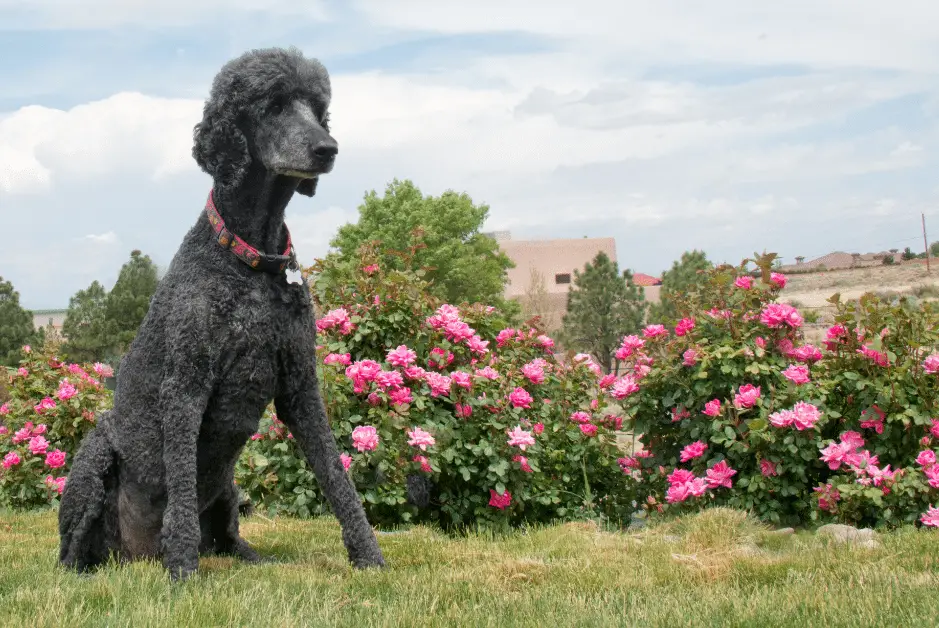Black has long been the most prevalent coat color seen in poodles. This dark hue is the most dominant and easily identifiable, contributing to its widespread appeal. However, beneath the surface, poodle coats can exhibit deeper complexity.

While all poodles share the same playful, bright-eyed temperament, their exact coat composition is not always as it seems. Three variants—true black, blue, and silver—each present as black at first glance. Yet subtle underlying tones may emerge over time.
What Will You Learn? 👇
Is my poodle black or blue?
Poodles are unique in the sense that three different types of puppies can be born to look black. The truth is, unless you know your poodle, these breeds have variants of coat colors.

Read our Smart Poodles - Smart Tricks eBook for only $2.99
Dive into a treasure trove of engaging tricks and tips designed specifically for your poodle!
If you want a full black poodle, this is best known as a “true black.” As the name suggests, the poodle is entirely black, including its inner and outer coat, making it a true black. Plus, they will be full black on their face, and over time, their facial color won’t fade away.
The difference is that other poodles may be born black but have colors of blue and silver in their coat. At first, it’s hard to see as newborns have a mixture of hairs. However, as they get older, around 1-2 years, their coat sheds, and the colors become visible.
Because of this, there are often many blue poodles that get registered as black. Therefore you must know the above information before buying your dog. Another important reason why a true black remains black is that it has three specific enzymes: eumelanin, TRP1, and TRP2.
Ultimately to know your poodle is a true black dog, you will need to shave its hair and see if the hair color remains the same.
Sometimes you can also stumble into a diluted black color, that can closely resemble the silver poodle.
How Big Can A Black Poodle Get?
A black poodle’s ultimate size is influenced by genetic and environmental factors. Genetics play a key role – the size of the parents is a strong predictor. Poodles from larger parent breeds like standards or kleins will generally grow larger as well.
Diet during puppyhood also impacts size. Puppies fed high-quality protein and calories will reach their genetic growth potential. In contrast, malnutrition or vitamin/mineral deficiencies can stunt a puppy’s growth trajectory.
Proper exercise also supports healthy size development. Daily walks and play sessions allow puppies to burn excess calories while building strong muscles and bones. Insufficient activity during formative months may result in a smaller stature.
On average, black poodles fall within the following sizes based on breed type. However, genetics, nutrition and exercise will cause some variance. With superior care, poodles may achieve sizes at the upper end of estimates or even surpass standards. Subpar rearing could yield smaller frames despite genetic predispositions.
| Height | Weight | |
| Standard black poodle | 20 to 23 inches (50 to 58 cm) | 45 to 80 pounds (45 to 36 kg) |
| Klein black poodle | 15 to 20 inches (38 to 50 cm) | 40 to 50 pounds (18 to 22 kg) |
| Miniature black poodle | 11 to 15 inches (27 to 38 cm) | 14 to 18 pounds (6 to 8 kg) |
| Toy black poodle | 8 to 10 inches (20 to 25 cm) | 6 to 9 pounds (2 to 4 kg) |
Black Poodle Puppies vs. Black Toy Poodles (what is the difference)

Poodle breeds are magnificent, and in the poodle family, there are three in total. One of which looks like a petite and cuddly teddy bear, known as a toy poodle. Black toy poodle popularity is among the highest out of all toy poodle colors.
Out of them all, the toy poodle is the smallest breed and grows up to 10 inches tall. Their curly coat requires a lot more grooming and sometimes more than the other poodle breeds do.
On the contrary, a standard poodle’s height can go up to 15 inches tall. These dogs are never aggressive, are affectionate, and happy. Plus, they are great guard dogs and observers and let you know if you have guests or visitors.
Besides the two breeds’ nature, temperament, and height, they both come in similar colors. One common color you can find in both is black.
What can I expect from a black poodle’s temperament?
The black poodle is a popular breed of dog that is known for its friendly and outgoing temperament. These dogs are intelligent and easy to train, making them a great choice for families with children. Black poodles are also active and playful, so they need plenty of exercises to stay happy and healthy.
Could they become aggressive?
Their natural temperament does not incorporate aggression. Black poodles can become aggressive when frightened or anxious. In particular, the toy and miniature poodle can become aggressive in this situation.
At times, poodles can be aggressive, depending on what influences their mood. Such factors that can impact their aggression are boredom, lots of energy, or they’re frightened. If you have a black poodle and want to see if it’s aggressive, then the typical warning signs are barking, lunging, gnarling, and biting.
If you do find they are displaying signs of aggression, this is a trait that can quickly be resolved through proper training & excercise.
How long will my black poodle live?
Generally, black poodles can live for 10-15 years. However, each sub-breeds lifespan can vary accordingly. Sometimes black poodles can be prone to several illnesses or diseases that can cause them to pass away sooner than others.
There are a few key factors that impact longevity:
- Size: In general, smaller poodles like toys live shorter than standards which have lifespans closer to large breed dogs.
- Health: Genetics plays a role in susceptibility to diseases. Well-bred poodles from health-tested parents tend to have stronger constitutions.
- Care: Proper nutrition, regular exercise and preventative healthcare from a vet enable poodles’ natural durability. Obesity and neglect shorten lives.
- Chance: As with all dogs, an individual poodle’s longevity depends on avoiding accidental injuries or developing unexpected illnesses beyond average risks.
What health issues are they prone to?
Black poodles can be prone to a few typical health problems. Tracheal collapse is a condition where cartilage in the windpipe weakens, causing it to flatten during exercise or excitement. Signs include coughing, gagging or noisy breathing. Prevention focuses on minimizing strain through leash-free play versus jogging. Supplements like glucosamine may also help.
Hip dysplasia is a genetic joint abnormality where the thighbone does not fit snugly into the hip socket. Symptoms range from limping to reluctance to climb stairs. Diet high in antioxidants and moderate exercise from a young age can help build strong bones and joints. Look for bredlines screened by the Orthopedic Foundation for Animals.
Eye diseases like cataracts and glaucoma are also concerns as poodles age. Watch for cloudy eyes, redness, squinting or watering that persists beyond morning. Yearly exams by a vet ophthalmologist can catch issues early. Some cancers too are more prevalent in older poodles. Regular skin checks and bloodwork screens for trouble signs. Overall, a balanced lifestyle and diet plus preventive healthcare keeps black poodles healthy and happy.
Caring and Grooming a Black Poodle
Caring for a black poodle’s unique coat requires regular maintenance. Begin brushing 2-3 times weekly with a slicker brush or comb designed for curly coats. This distributes natural oils down the shaft while removing loose hair and dirt.
For bathing, choose a moisturizing shampoo without dyes, preferrably with ingredients like oatmeal or aloe vera to soothe the skin. Rinse thoroughly and avoid excessive bathing which can dry out the coat. Spot clean as needed.
To prevent mats, gently detangle any knots starting from the bottom up. Regular brisket brushing and undercoat raking helps remove dead hair. Professional stripping every 4-6 weeks is recommended for serious show dogs.
Nails should be dremeled or clipped every 3-4 weeks to the quick. Bad nails can impact structure and gait. Brush teeth daily with a vet-formulated canine toothpaste and soft brush to remove plaque and freshen breath. Raw hide chews can aid in this.
For food, select a high protein diet suited for an active breed from a reputable brand. Split meals throughout the day and always keep fresh, clean water available. Consistent care is key to keeping a black poodle’s coat and overall health in peak condition.
Will their coat fade over time?

Black poodles fade due to three key reasons:
- Genetics – They are not truly black but another color underneath like blue or silver that lightens with age.
- Sun exposure – Ultraviolet rays from the sun bleach the coat over time.
- Grooming products – Harsh shampoos can strip the outer coat and accelerate fading.
By age maturity, 60% of black poodles fade to grey. True black dogs have an 85% chance of lightening as seniors. The fading occurs gradually as protective pigment lessens. Owners should be aware black poodles may change hue with age rather than remaining completely black. Choosing grooming products carefully and minimizing sun exposure can help retain the outer coat’s color longer but fading ultimately stems from the dog’s natural coat composition.
Do poodles have black skin underneath?
Poodles do not have black skin. They may have black fur, but their skin is usually a light color. It can range from white to dark gray and even blueish.
How much is a black standard poodle puppy?
Here are the key factors that determine the price of a black standard poodle puppy:
- Breeder reputation – Puppies from top-rated kennels with champion bloodlines cost $1,500-$2,000 on average.
- Location – Urban areas have higher prices than rural regions due to supply and demand.
- Age – Older puppies nearing adoption age of 12-16 weeks are $100-200 cheaper than younger 8 week puppies.
- Gender – Females intended for breeding may be $200 more than males.
- Health guarantees – Reputable breeders provide hip certifications, health testing of parents lowering buyer risk.
Most black standard poodle puppies from average breeders fall in the range of $800-1200. Adopting a retired show or agility dog is $500-800. Buyers can expect $80-150 annually in routine vet care, food, toys and $150-300 every 4-6 weeks for professional grooming. Factoring all costs, the first year usually totals $2,000-3,000.
Buying or adopting a black poodle?
If you’re looking for a black poodle to be a new addition to your family, you may be posed with the question, do you buy or adopt? Depending on your reason for the poodle, buying or adopting can have different benefits.
If you want to enter your poodle into contests, we suggest purchasing a black poodle directly from a breeder. When you buy from them, a lot of the time, the poodle has already had vaccines, gone through tests, and is mainly healthy. On the contrary, if you choose to buy a poodle directly from a kennel, it’s going to be more expensive.
Black poodle breeders are full of knowledge, as it is their specialty. Therefore most dogs are healthy, and you can ask them a lot of information right then and there. To know if you’re buying from a good breeder, look out to see if the breeder is passionate, informative, and has health-tested their animals.
On the other hand, if you wish to adopt a black poodle, you will feel good about it as most poodles who end up at the shelter have been neglected by previous owners. When adopting a black poodle, you will get to choose (based on the availability) an adult or a puppy. Because they’re looked after, many dogs in a shelter have been tested for their temperament.
Therefore before you adopt this dog breed, you can know if its temperament matches what you’re looking for. Finally, if you choose to adopt a black poodle from a shelter, expect to pay up to a couple of hundred dollars. However, they’ve usually had their vaccinations and health checkups.
Share Your Black Poodle Experience
We hope this article helped provide useful information on caring for and understanding black poodles. To make our content even more valuable for other poodle parents, please feel free to share your own experiences in the comments. Did you have questions about your black poodle’s coat color? How did diet, exercise or grooming impact your pup’s size?
We’d love to hear real-world anecdotes or case studies. For example, if rigorous training and a raw diet helped your standard poodle achieve show-quality musculature, sharing those insights could inspire others. Comments including training tips or advice from your vet are also greatly appreciated. By collaborating as a community, we can continuously improve and expand this knowledge base to better serve all black poodle owners.
Marko is the founder and author at PoodleHQ, where he blends profound expertise with formal training in Animal Behavior and Canine Genetics. With multiple generations of poodles under his care, he’s a breed connoisseur, honored with the Canine Care Excellence Award and lauded by the International Pet Enthusiasts Association.

